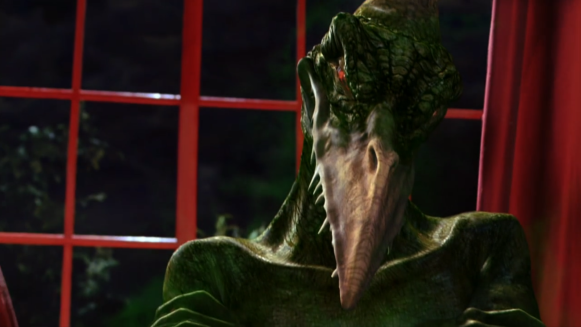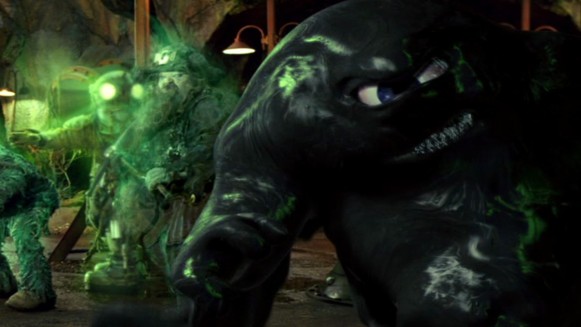Written by Daniel – In 2017, I wrote two dissertations for my undergraduate, one on cosplays of Harley Quinn and the other on interventionism and internationalism in Scooby-Doo! So this post is really just an ego trip, as I treat myself to combing my two interests in costume and Scooby-Doo! I’m curious about how costumes, fancy-dress, and cosplay posses narratives, and in taking on these narratives through our clothing we change ourselves into someone else, our identity transforms, and we encourage others to see us differently. It’s the narratives that these costumes posses which are used by their wearers to adapt how they’d conventionally like to be perceived. Such dress changes not only their appearance but how we ought to interact with them, and how they interact with everyone else. Scooby-Doo 2: Monsters Unleashed (2004) is a great jumping board for this discussion, because the costumes in this film have no wearers. In this film, it’s not just a costume, but the costumes are actually monsters!

Since 1969 Scooby-Doo and the Mystery Inc. gang have been traveling the world unmasking monsters for who they really are: bitter business men and women trying to scare away competition, investors, locals, or members of the public. Now in its 50th year, the show continues to depict the Mystery Inc. Gang unmask those behaving as monsters. However, in Scooby-Doo 2 written by James Gunn who has gone on to write and direct The Guardians of the Galaxy films, this film sees in its opening minuets an exhibition of costumes from some of Scooby-Doo’s most iconic mysteries. But the exhibition launch is cut short as the costumes are stolen from the gang, only to be brought back to life by an evil masked figure, who wants to see Mystery Inc. come to an end. In this film the monsters are no longer frail bitter humans to be unmasked but they embody the supernatural and the otherworldly, the codes and signs sewn in to fabric are brought into the real material world.
I place a distinct emphasis on the relationship between the cosplayer and their chosen character, whilst this is not the case for all cosplayers, many participants choose their characters based on a set of shared traits with their chosen character, or a means of expressing parts of themselves they couldn’t otherwise achieve. Looking at the original iterations of some of the monsters which are seen in Monsters Unleashed we can identify some of the shared traits between the monster and the wearer.
The Tar Monster is unmasked as a man named Stoner, who’d used the monster to scare away people from “The Lost City”, so he could find the treasure for himself. The monster is believed to be made of tar with it’s distinctive connection with the location of tar pits. Yet is obviously revealed later as just an elaborate costume. Stoner wants the location for himself, and through his costume he is made to appear to have become a part of the very geography of the tar pits. The living tar monster is then made of real hot tar, able to morph in its shape, and as we see in the film proves to be quite a threatening creature.
Secondly, Miner Forty-Niner is unmasked to be a man named Hank, using the costume to scare off employers and guests of a Guest Ranch, so that he could buy the land for the cheap from the owner. The monster is believed to be the ghost of a miner obsessed with finding the last vein of gold in the area. Much like his ghostly creation, Hank seeks riches, to own the ranch, and to make money! Just as a mining prospector seeks out his riches. Turning to the ‘real’ Miner Forty-Niner, they are subsequently a translucent Spector, found wondering a mine-shaft of Coolsville he becomes the lost miner searching for gold (even if there is no land to steal any more).
Finally, the Ghost of Captain Cutler, in the original series Captain Cutler died only to come back and haunt Rocky Point Beach, though as Mystery Inc. uncovered the Ghost was in fact Captain Cutler himself, after faking his own death, used the ghost to steel yachts. He was a green glowing creature, covered in seaweed. In this case the man is costuming as himself! In the film, it’s the myth which takes president yet again as the costume is brought to life. The ghost appears as a translucent figure, with the addition of a harpoon gun, his scare tactics are notably heightened without the individual motivation of yachts theft.

Of course when all these creatures are brought to life, they do not come with the unique motifs of the original wearers, rather a more direct aim of scaring people. Each motivated by scaring people away, and taking lands for their own gain. It is the objective of the costume removed from the uniqueness of the individual wearer. The narratives are brought to life in the events of this film to torment the Mystery Inc. gang, and this time the monsters aren’t restrained by their wearers. This time the legends and stories behind the costumes are very real, and very threatening.
It’s this prevalence of the monsters as frightening characters in Scooby-Doo! rather than costumes which exaggerates the very functions of clothing and fancy dress. It’s the iconography and narratives that clothes embody which effect our readings of individuals who wear these storytelling items. If a woman is dressed up as Maleficent this Halloween, to what extent is she herself and to what extent is she Maleficent? She takes upon qualities of the magical, the fantastical and the other worldly. Just as the Tar Monster embodies the qualities of hot running tar, a Maleficent cosplayer uses latex horns and make-up, perhapse even strap-on wings to adapt the physicality of their human body. In a way as to present them as nonhuman.
If we appear as Harley Quinn the clown princess of crime, we are a crazed criminal with relationship problems. Even if the costumer may not necessary feel a connection with the character, these are inevitably the narratives and the stories we choose to share through our presentation. Just as the real Miner Forty-Niner continues his search in the mines, pick-axe in hand, despite there being no motivation of the cheap ranch land. The Harley Quinn costumer takes to the part foam bat in hand looking for a laugh.
We might also ask, how do costumes express something about the wearer? If a man is dressed as a fantasy wizard, staff in hand and spell book clutched at his side. It is often the case that people who dress up as a character, choose that character because they feel some connection with the character. When we are in costume, to all extensive purposes we are who we present ourselves as, through our interactions (and perhaps performances) with others. Captain Cutler becomes his own ghost, people become scared of him in his new guise. Just as our wizard is now capable of concurring, in this shared performative belief in embodiment.
Costumers who take on characters from popular media bring life to a costume, just as the criminals from Scooby-Doo! did, or just as Shaggy and Scooby-Doo do, as they so often attempt to fool the monsters chasing after them. But the costume still holds onto these narratives with or without them. This is after all why we change in to a costume, and thus highlighting that our bodies are susceptible to mediated languages. It’s why people interact with us differently if we decide to dress unconventionally whether that be through costume or just day-to-day life. We present something about ourselves in clothes and costumes. So what ever you’re dressing as for Halloween, why’d you choose the character? What will you say with your costume? Whatever it may be have fun and have a happy Halloween folks!!
A little extra post:
Costume designers and producers who ask themselves, “what will people want to dress up as for Halloween?” are sure to see some good merchandise money roll in.
This years most in demand Halloween costumes according to Google Freightgeist are:
In at number 3 – Spider-Man
At number 2 – Witch
And finally the most in demand costume of 2019, at number 1 is – IT
I’ve been keeping a close eye on Halloween costumes for four years now, and unsurprisingly they are consistently heavily influenced by the films released in each year. I’m particularly interested in tracking Harley Quinn’s rankings (who was the most demanded in 2016 following the release of ‘Suicide Squad’) with Joker as the 2nd most demanded character. Yet three years on, Harley Quinn sees herself in 15th place, and Joker even lower in 27th. This is despite the anticipated ‘Birds of Prey’ and the (divisive but) successful ‘Joker’.
This drop in rankings raises some questions. Is the wider public imagination around these characters dwindling? Is it more about costume design? Or the result of something else?Another aspect is that ‘Suicide Squad’ encouraged many couples cosplays, the two characters popularity is no doubt the same for couples at Halloween. Their separation in film, appears to have been replicated in Halloween fancy dress.
Say what you will about ‘Suicide Squad’, the costumes are brilliant, they’re practically designed to be merchandised and cosplayed. The new spectacular look of Quinn in ‘Birds of Prey’ results in a much more expensive costume, and then the new Joker’s costume is just dull.


